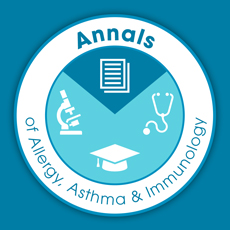 The January 2018 issue of the Annals of Allergy, Asthma and Immunology launches the renewed effort of our journal to serve our readers with the highest possible quality publication features. We have a great new team of editors and support staff who are working very hard to make our journal greater than it ever has been. Of course, the final metric is the quality of the material we publish and its utility to you. In that regard, we have many features that offer “something for everyone” in this issue. Two such manuscripts deserve special mention.
The January 2018 issue of the Annals of Allergy, Asthma and Immunology launches the renewed effort of our journal to serve our readers with the highest possible quality publication features. We have a great new team of editors and support staff who are working very hard to make our journal greater than it ever has been. Of course, the final metric is the quality of the material we publish and its utility to you. In that regard, we have many features that offer “something for everyone” in this issue. Two such manuscripts deserve special mention.
The first is a CME review article by Drs. Neema Izadi and Donald Y.M. Leung that describes a scholarly yet pragmatic approach to diagnosis and management of the patient with difficult-to-treat atopic dermatitis (AD). As in all medical disorders, the authors emphasize a measured approach, particularly related to looking critically at the diagnosis as there are many AD mimickers. Once the diagnosis is confirmed, the treatment plan must be carefully examined in terms of both the primary therapeutic choices made as well as patient adherence to the treatment plan. Once this is confirmed and the patient is still not optimally controlled, other factors should be considered including aggravating factors (which the authors point out can be difficult to identify unless/until the patient is initially cleared), emphasis on maintenance of therapy once control is achieved and the need for additional therapy in suboptimally responsive patients.
Another interesting paper authored by Dr. Andrzej Bozek and colleagues, describes the results of a pilot trial of birch pollen immunotherapy in patients with local allergic rhinitis (AR), defined as patients who clearly have exposure-related AR symptoms yet are skin test and in vitro test negative for allergen-specific IgE. Other studies have shown the production of localized (nasal) IgE in patients such as these. In this study, 28 patients with seasonal allergic rhinitis (SAR) underwent two years of AIT (15) vs placebo (13). Primary outcome measure was the symptom medication score which was statistically improved in the treatment compared to placebo group. Additionally, there was a decrease in intranasal birch-specific IgE with a concomitant increase in birch-specific IgG4. This is a provocative study that suggests active intervention could be a therapeutic option for patients such as this if practical ways of identifying them in an office setting can be developed.
As always, we are interested in your feedback for these and other features in each issue of the Annals. Let us know what we can do to make this a more valuable asset for you, our readers.
Gailen D. Marshall, Jr., MD PhD, FACAAI
Editor-in-chief

